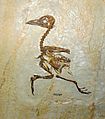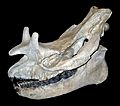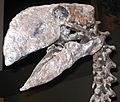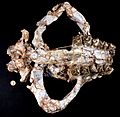Eocene facts for kids
The Eocene was a super long time ago, a special period in Earth's history. It was the second part of the Palaeogene era. This amazing time started about 56 million years ago and ended around 33.9 million years ago. Before the Eocene came the Paleocene, and after it, the Oligocene.
The Eocene, like the Paleocene before it, had a climate much warmer than today. At the very start of the Eocene, Earth experienced a huge warming event. This event is called the Palaeocene–Eocene Thermal Maximum. It lasted for about 100,000 years. This extreme heat caused a large extinction event, meaning many plants and animals disappeared.
During the Eocene, most of the land was covered in thick forests. Even places like the arctic and antarctic regions had temperate forests. This means they were not covered in ice like today! Many plant-eating mammals, called herbivores, were browsers. This means they ate leaves and twigs from trees and bushes, not grass. Grasslands were not common yet.
Contents
Animals of the Eocene
The Eocene was a time when many new types of animals appeared and grew. Mammals especially became very diverse.
Early Mammals
Many of the mammals during the Eocene were quite different from the ones we see today.
- Early Horses: One interesting animal was Hyracotherium. It was a very small ancestor of today's horses, only about the size of a dog. It had multiple toes, unlike modern horses.
- Giant Mammals: Uintatherium was a huge, rhino-like mammal. It had strange bony growths on its head, almost like horns. Coryphodon was another large, plant-eating mammal that lived in swampy areas.
- Carnivores: Andrewsarchus was one of the largest meat-eating mammals ever. It looked a bit like a giant wolf or bear, but it was related to hoofed animals. Tritemnodon and Hesperocyon were also early predators.
- Other Mammals: Leptictidium was a small, long-legged mammal that hopped like a kangaroo. Peratherium was an early marsupial, like a possum. Hyracodon was a fast-running rhino ancestor.
Ancient Whales
The Eocene was a very important time for the evolution of whales.
- Walking Whales: Pakicetus was one of the earliest ancestors of whales. It lived near water and had legs, but its ear structure shows it was related to whales.
- Sea Serpents: Basilosaurus was a very long, snake-like whale that lived entirely in the ocean. It was a top predator in the Eocene seas.
Birds and Reptiles
Birds and reptiles also thrived during this period.
- Terror Birds: Gastornis was a huge, flightless bird. It stood very tall and had a massive beak, likely used for crushing plants or perhaps even small animals.
- Early Rollers: Primobucco was an early relative of modern rollers, which are colorful birds found today.
- Crocodiles: Borealosuchus was a type of crocodile that lived in North America. Eocene turtles were also common, as seen in fossils.
The End of the Eocene
The Eocene period came to an end about 33.9 million years ago. This marked the beginning of the Oligocene epoch. This change was not smooth; it included a major event called the Eocene–Oligocene extinction event.
During this extinction event, many plant and animal species died out. Scientists believe this was likely caused by large meteorite strikes. Evidence suggests impacts in places like Siberia and Chesapeake Bay might have played a role. These impacts could have caused big changes in the climate and environment, leading to the extinction of many species.
Images for kids
-
Cast of Uintatherium anceps skull, French National Museum of Natural History, Paris
See also
 In Spanish: Eoceno para niños
In Spanish: Eoceno para niños

















